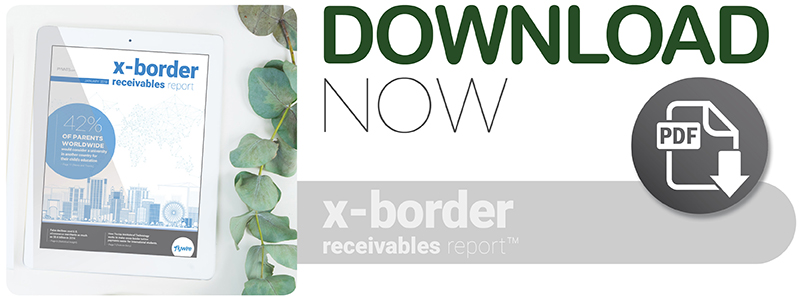TRENDING: How Managing X-Border Tuition Receivables Helps Manage Student Debt

A new year is bringing new changes to the cross-border trade cycle, from logistics and freight to B2B payments.
Recently, several companies swimming in the ever-shifting seas of global trade looked to fulfill their goal of making international payments less cumbersome with new solutions. Meanwhile, recipients remain eager to spend less time worrying and waiting for their funds to arrive.
The latest PYMNTS.com X-Border Receivables Report, powered by Flywire, looks at new developments in the global commerce world that are working to help trading partners improve their relationships by exchanging funds more quickly.
Around the X-Border World
Cross-border trade is often mired with great many pain points – but some recently launched solutions are aiming to make it a lot less painful, at least when it comes to sending and receiving payments.
In Nigeria, for instance, retailers recently gained access to a new tool to help them send and receive funds to and from their customers. The service from PayU Nigeria, called PayU Receive, helps Nigerian businesses process both business-to-business and business-to-consumer payments via email or SMS communications. The service can be used to make both international and domestic payment requests.
Other companies set their sights on changing how the freight industry manages payments. To that end, payment platform service PayCargo recently introduced a new freight payment solution in the European market. The company’s solution is designed to help shippers by delivering a “Payment Approval” notification to let them know it’s safe to release their cargo for delivery, and also helps to reduce the costs of requesting payments and mailing checks.
Meanwhile, there are also new players emerging in the global trade space. Most notably, Amazon launched its full-fledged service in Australia late last year. The company’s arrival down under could help local Australian merchants tap into the country’s eCommerce market, which is valued at an estimated USD 23 billion, and easily receive payment through Amazon’s platform.
Data Dive: Marketplaces
While consumers turn to global marketplaces to find items they can’t get locally, the merchants serving them typically rely on marketplaces to sell to a wider customer base and expose more consumers to their products and brands.
Recent research indicates that about two-thirds of cross-border online shopping is performed through digital marketplaces. What’s more, the market for these services is expected to grow at a compound annual growth rate of 17 percent between 2017 and 2022. But first, participating merchants must face various challenges related to inefficiencies and costs associated with receiving cross-border payments.
This month’s report includes a Deep Dive on the state of global marketplaces, and how they are helping merchants expand their reach and seamlessly send and receive payments.
What Universities Can Learn About International Tuition
The international education market is also trending upward recently.
In 2017 alone, an estimated 4.6 million students pursued international education abroad. For universities, accommodating a growing number of international students comes with a host of challenges – and chief among them are receiving overseas tuition payments.
For the January report, PYMNTS spoke with Terri Carter, Florida Institute of Technology’s director of student financial services, about how the university overcame this challenge while helping students avoid costly debt. To read the full story, check out this month’s report.
About The Report
The PYMNTS X-Border Receivables Report, powered by Flywire, is your go-to resource for staying up to date on a bimonthly basis on the notable changes and shifts in the cross-border receivables market.
